- Home
- Past News & events
- 2016
The Herculaneum papyri between science and philosophy

26th January 2016
Location: Palazzina dell’Auditorio, via della Lungara 230, Rome
The conference presents recent scientific results on Herculaneum papyri studied using novel technologies using synchrothron radiation facility at the SRF.
More Info:
Program
Related Links:
Centro Linceo Interdisciplinare
CNR
X-ray-to illuminate carbonized papyri
Human Cells Reprogramming in Microgravity: role of Endocannabinoid
Osteoporosis increase the risk of bone fracture in the elderly due to the loss of muscle mass and the decrease in bone mineral density. Researcher from NAST Centre has patented an innovative experimental model of osteogenesi, where hematic cells in deprogrammed in staminla cells induced to an osteogenitic differentiaiton, allow to directly study the role of both endocannabinoidi and other moleculr signals in the process of loose of bone mass occuring in microgravity conditions.
This study has triggered the SERIM research project -“Ruolo del Sistema Endocannabinoide sulla Riprogrammazione di Cellule Staminali Pluripotenti Umane in Microgravità” – supported by ASI (Italian Space Agency) within the Human mission Expedition 52/53).
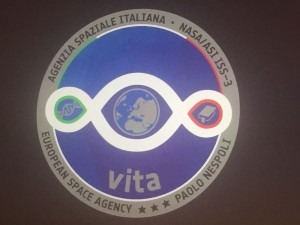
Further Information
Research project by NAST Centre in collaboration with Department of Experimental Medicine and Surgery, Campus Biomedico in Rome, University of Teramo and Kayser Italia srl
Dr. Alessandra Gambacurta
Senior researcher at NAST Centre
University of Rome Tor Vergata,
gambacur@uniroma2.it
Related Links :
University of Tor Vergata
Il messaggero
Wired
Astronauti news
Date: November 2016
The Eighth ATAC and NTAC Review Meeting at CSNS 2016
Eighth Chinese Spallation Neutron Source International Advisory Committee Review Meeting to be held from Nov. 1-3, 2016 at CSNS Site, Dongguan, China.
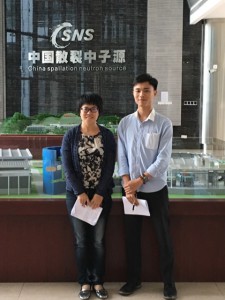
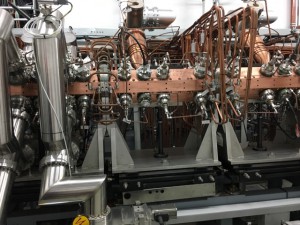
Jing Shi Zhao and Boyang Gu (top left). Details of the Linac (top right and bottom left) and of the experimental hall (bottom left). Group Photo and bird view of the CSNS facility.
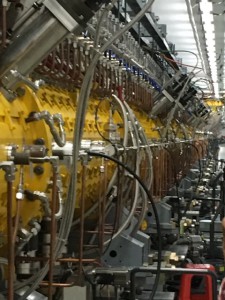
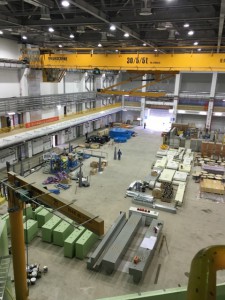
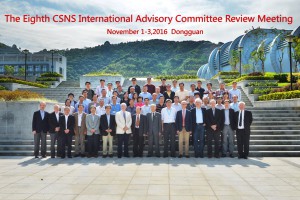

Neutrons to unveil the secrets of Violins and Egyptian artifacts
Scientists from NAST Centre are now able to capture previously elusive details about ancient Italian violins, by Amati and Testore, and the Egyptian grave-goods of Kha thanks to a new instrument, IMAT, which has the ability to reveal hidden images of these objects for the first time. The study is performed within the ARKHA project.
IMAT was opened today in the presence of H. E. Pasquale Terracciano, Italian Ambassador in London, by Corrado Spinella, Director of the Department of Physics of the Italian National Research Council (the CNR) and ISIS Director Robert McGreevy, in a celebration of the long-standing partnership between the UK and Italy.
The new imaging capabilities of IMAT enable scientists to access key information on the effects that the choice of different materials in violin has on the sound they produce, as well as the methods used by ancient Egyptians to make vases and alabasters.

Egyptian Artefact mounted on the neutron beamline
Cultural heritage studies of this kind, along with a number of other research areas, have expanded as a result of the Italian collaboration with the ISIS Neutron and Muon Source, a research facility supported by the Science and Technology Facilities Council. The agreement between CNR and ISIS was originally signed in 1985, making Italy one of the major and longest-standing partners of the research facility.
Today, the relationship between ISIS and Italy was celebrated with the opening of IMAT, the first instrument at ISIS capable of producing 3-dimensional images to reveal the inner workings of components across a wide range of science and technology areas.
H. E. Pasquale Terracciano, Italian Ambassador in London said: “This is a flagship European partnership of which both UK and Italy can be proud. We look forward to the continued success of this partnership far into the future.”
Dr Corrado Spinella, Director of the Department of Physics of the Italian National Research Council (the CNR) said: “It is wonderful to mark this milestone in the relationship between ISIS and Italy. Continued access to ISIS will be a key element of the Italian neutron research infrastructure strategy.”
Professor Robert McGreevy, Director of ISIS added: “We are delighted to be able to celebrate the inauguration of IMAT with our colleagues from CNR and H. E. Terracciano. Our partnership with Italy has brought extensive benefits not just to our two countries but the wider scientific community. The studies taking place today will provide important insights into our cultural heritage. Longer term, we expect to see IMAT enable advances in a wide range of applications, from aerospace, civil engineering and power generation to earth science and agriculture.”
Antonio Stradivari (1644 – 1737) was one of the greatest luthiers of all time. His interpretation of geometry and design for the violin has served as a conceptual model for violin-makers for more than 300 years.
Today a team of scientists from the Italian National Research Council CNR, Tarisio (London), Fondazione Pro Canale (Milan), University of Milano-Bicocca and University of Rome Tor Vergata, are investigating the craftsmanship of ancient Italian violins using neutron beams. The team wishes to explore how the wood, only a few millimetres thick, was used to construct the instrument, and how small details in the finishing and varnishing processes influence the sound production. Due to their peculiar shape and high value, violins are difficult objects to study with standard analytical techniques. IMAT offers a non-destructive method by which the entire instrument can be imaged. These experiments form part of a wider project that aims for the integrated analysis of musical instruments.
More than 3,000 years before Stradivari’s time, between 1425 and 1353 BC, Kha was overseeing the building of tombs for the kings of ancient Egypt. Previously, all that was known about Kha was taken from his mud brick funerary chapel. Until 1906, when an Italian archaeological mission discovered the shaft of Kha’s own tomb that had been sealed by a landslide. It was the richest and most complete non-royal burial assemblage ever found. Kha’s grave goods included coffin tunics, beds, vases and prestigious luxury objects inscribed with royal names, as well as alabaster containers, ceramic vessels and jars for food, oil powders and perfumes, some of which still remain sealed with their contents unknown.
Now, a selection of the Egyptian artefacts taken from Kha’s tomb, including vases and alabasters, are being studied on IMAT as part of the ARKHA project. Using neutron beams, which have a high penetration power in metals, the team will find clues on the methods used by ancient Egyptians to make the bronze vases and pots, as well as the state of their conservation.

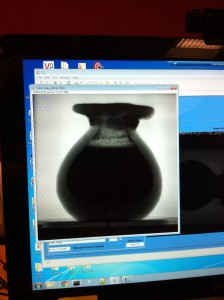
The neutron tomography of a sealed alabaster vessel from the Egyptian Museum of Turin reveals the elemental composition of its contents.
Christian Greco, Director of Museo Egizio said: “On the 2nd of October, 11 vases from the funerary goods of the tomb of Kha have been sent to the ISIS laboratory where they will be studied with the help of neutron beams in order to discover what is hidden inside these precious objects. We strongly believe in the collaboration between archaeologists and researchers in Chemistry and Physics that this project aims at promoting. It is an especially important initiative this year which marks the 110th anniversary of the discovery of the tomb of Kha by Ernesto Schiaparelli, dating back to 1906, because it represents an opportunity to offer to the public new data and useful new results about the objects belonging to our collection”.
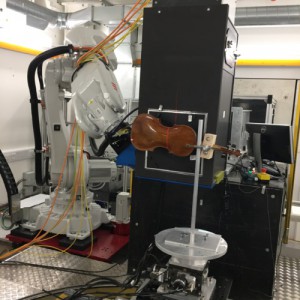 Amati Violin monted on IMAT ready to be scanned
Amati Violin monted on IMAT ready to be scanned
Carlo Chiesa from Fondazione Pro Canale, a Violin maker who acted as a consultant for the project, said: “New analytical methods will help us understand and rediscover techniques that three or four Century ago were a common knowledge in the small community of cremonese violin makers and allowed them to produce the small number of violins that are still unsurpassed for their acoustical properties.”
Prof Carla Andreani, who coordinates the Italian team on behalf of University Rome Tor Vergata added: “The two violins by Amati and Testore became the first ever stringed instruments to be scanned by a neutron beam at ISIS. In a few months, with the combined images produced with the contribution of all the partners of the project, we will be able to complete the elemental analysis using neutron resonances at higher energies and tomography and using thermal neutrons, and provide more complete information on inner structure and morphology of the Violins.”
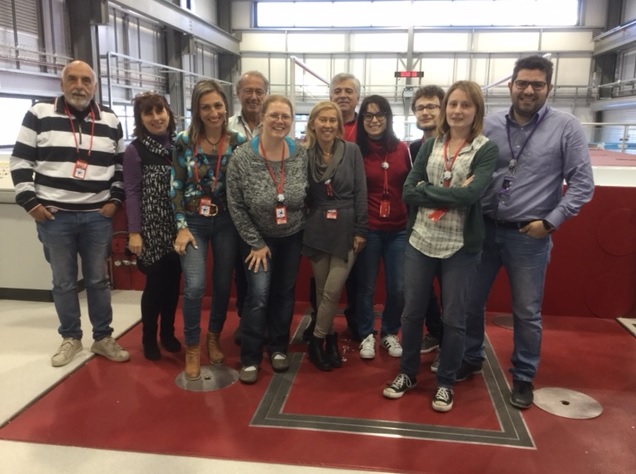
Researchers of CNR, NAST Centre, Egyptian Museum, “Archaeology Superintendent, fine arts and landscape for the metropolotana city of Turin”
Prof. Giuseppe Gorini from University of Milano Bicocca said: “The collaboration allowed the temporary exportation of the objects from Italy to be analyzed at the ISIS neutron source. Restoration experts – from the Museo Egizio in Turin and Soprintendenza Archeologia del Piemonte – and University researchers worked closely, providing a positive example of multidisciplinary collaboration.”
FURTHER INFORMATION
ARKHA (ARchaeology of the invisible: unveiling the grave goods of KHA) project. Objective of the study is to characterize the “Kha and Merit collection”, by the integrated use of non invasive and non destructive chemical and physical techniques by the integrated use of light and neutron probes. ARKHA combines competences of scientists belonging to different disciplinary fields, i.e curators, restorations, Egyptologists, archeologists, chemists and physicists.
ARKHA project is a collaboration partnership among:
Università degli Studi di Roma Tor Vergata (coordinator)
Museo Egizio di Torino
Soprintendenza Archeologia, Belle Arti e Paesaggio per la Città Metropolitana di Torino
Università degli Studi di Milano-Bicocca
IMAT details
The IMAT beamline is a new instrument at the Science Technology Facilities Council’s ISIS Neutron and Muon Source. It will be the first instrument at ISIS capable of producing 3-dimensional images, revealing the inner workings of components across a wide range of science and technology areas.
The images produced by IMAT will have applications in the areas of aerospace and transportation, civil engineering, power generation, earth sciences, cultural heritage and agriculture. As neutrons can penetrate deeply into materials, IMAT will be capable of producing images of the internal structure of large engineering components. It will reveal, for example, the passage of lubricants and fuel through engine components, and the internal stresses and strains inside welded components.
IMAT has been built using funds provided by the UK government, together with imaging systems developed by Italian scientists from CNR-IPCF, funded through the Italian CNR research council.

The IMAT blockhouse
PRESS
University of Rome Tor Vergata
Egyptian Museum in Turin
ISIS Neutron and Muon Source
Tarisio London
University Milano Bicocca
RELATED LINKS
ISIS Neutron and Muon Source on Twitter
BBC clip
TG Leonardo
UK lab helps reveal secrets of 3000 year old Egyptian vases – STFC News
RESEARCH DATE: October 2016
UCANS VI Meeting, 25-28 October 2016 at Xian, China
Advances in science and technology in the field of neutron science have been dominated by a fruitful combination of major international facilities supported by networks of smaller regional facilities. Recent advances in accelerator technology and neutronic design have made it possible to construct small-scale accelerator-driven neutron facilities that would be able to play a significant role in neutron technology and science. The neutron applications using compact accelerator driven neutron sources are now becoming more and more important since it can cover various fields such as material science, engineering, nuclear physics, cancer therapy, soft error and so on, therefore, they would play more significant role in the future.
 Locations: X i’an Jiaotong University, Xian, China
Locations: X i’an Jiaotong University, Xian, China
Date: 25-28 October, 2016
Light probes to unveil painting practices used in ancient Egypt
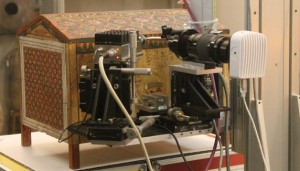 A large collection of artifacts from the Egyptian Museum of Turin was studied for the first time using analytical techniques. The study is performed within the ARKHA project. The collection is part of objects coming from one of the tombs discovered by Ernesto Schiapparelli’s Italian archaeological mission. In 1906 the archaeologist discovered the shaft of an underground tomb, containing the intact burial assemblage of two upper-class individuals, ‘the director of works’ Kha and his wife Merit. It was the richest and most complete non-royal burial assemblage ever discovered. Grave-goods include coffins tunics, beds, vases, cosmetics and prestigious luxury objects inscribed with royal names, which allowed to date his career between the reigns of Amenhotep II and Amenhotep III (1425-1353 BC). The grave-goods of Kha also include alabaster containers, ceramic vessels and jars for food, oil, powders and precious perfumes.
A large collection of artifacts from the Egyptian Museum of Turin was studied for the first time using analytical techniques. The study is performed within the ARKHA project. The collection is part of objects coming from one of the tombs discovered by Ernesto Schiapparelli’s Italian archaeological mission. In 1906 the archaeologist discovered the shaft of an underground tomb, containing the intact burial assemblage of two upper-class individuals, ‘the director of works’ Kha and his wife Merit. It was the richest and most complete non-royal burial assemblage ever discovered. Grave-goods include coffins tunics, beds, vases, cosmetics and prestigious luxury objects inscribed with royal names, which allowed to date his career between the reigns of Amenhotep II and Amenhotep III (1425-1353 BC). The grave-goods of Kha also include alabaster containers, ceramic vessels and jars for food, oil, powders and precious perfumes.
Painted caskets were studied by X-ray Fluorescence imaging. Results provide new clues on Egyptian painting techniques and the state of conservation of these ancient objects
Further Information
Researchers from NAST Centre applied for the first time non-invasive macro scan X-ray Fluorescence imaging (MA-XRF) to the Kha artifacts. The NAST Centre led an experimental team which included researchers from CNR Istituto per i Beni Archeologici e Monumentali (IBAM) of Catania and Istituto per i Processi Chimico Fisici (IPCF) of Messina, Museo Storico della Fisica e Centro Studi e Ricerche Enrico Fermi, the Museo delle Antichità Egizie di Torino and Soprintendenza Archeologia del Piemonte, Università degli Studi di Milano-Bicocca. The experimental apparatus was developed within a collaboration with CNR-IBAM and LANDIS laboratory of INFN-LNS. The new scanning methodology provided high-resolution images of the elemental distribution on the investigated paintings.
Preliminary results from the XRF scans of the Egyptian painted caskets coming for the Kha tomb already provided precious indications about the painting techniques applied, presence of different hands and their conservation status. The measurement campaign was performed in June 2016 at the Museo Egizio di Torino in the framework of a wider project aiming at the characterization of the intact Kha burial assemblage.
ARKHA (ARchaeology of the invisible: unveiling the grave goods of KHA) project. Objective of the study is to characterize the “Kha and Merit collection” by the integrated use of non invasive and non destructive chemical and physical techniques by the integrated use of light and neutron probes. ARKHA combines competences of scientists belonging to different disciplinary fields, i.e curators, restorations, Egyptologists, archeologists, chemists and physicists.
ARKHA project is a collaboration partnership among:
Università degli Studi di Roma Tor Vergata
Consiglio Nazionale delle Ricerche
Museo Egizio di Torino
Museo Storico della Fisica e Centro Studi e Ricerche “Enrico Fermi”
Soprintendenza Archeologia, Belle Arti e Paesaggio per la Città Metropolitana di Torino
Università degli Studi di Milano-Bicocca
Dr. Giulia Festa
Senior researcher at NAST Centre
University of Rome Tor Vergata,
giulia.festa@uniroma2.it
Related Links and Media
University of Tor Vergata
CNR Press Note
Media Gallery
Research date: July 2016
School: Plutonium Futures The Science 2016
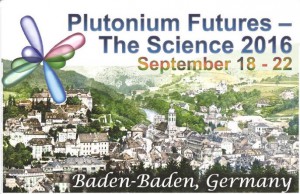
Plutonium Futures – The Science series of conferences provides an international forum for discussion of current research on physical and chemical properties of plutonium and other actinide elements in complex systems. In bringing the community together from diverse disciplines, the conference aims to enhance the dialogue among scientists and engineers on the fundamental properties of plutonium and their technological consequences.
Scientists, engineers, academics and students from universities, national laboratories, and the nuclear industry are encouraged to participate and make technical contributions.
18th September-22nd September 2016
Baden-Baden, Germany
Related Information :
Flyer
More Info
School: III Course of the ERICE School “Water and Water Systems”
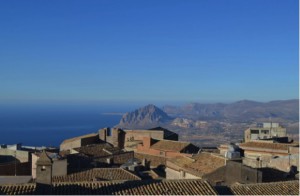
Ettore Majorana Foundation and Centre for Scientific Culture
Directors:
R. Car (Princeton Univ.) and F. Mallamace (Univ. of Messina)
22nd July – 31st July 2016, Erice (Italy)
Application deadline: 1st July 2016
More Info
Seminar: La superficie dipinta tra Scienza ed Arte: “Incontro con grandi Maestri”
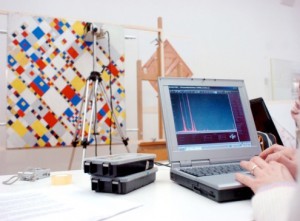 Prof. Antonio Sgamellotti, Accademia Nazionale dei Lincei, University of Perugia, CNR Institute of Molecular Sciences and Technologies
Prof. Antonio Sgamellotti, Accademia Nazionale dei Lincei, University of Perugia, CNR Institute of Molecular Sciences and Technologies
La superficie dipinta tra Scienza ed Arte: “Incontro con grandi Maestri”
13th June 2016
Location: Aula Magna “P. Gismondi” Macroarea di Scienze M.F.N. – University of Rome Tor Vergata
Workshop: Italian-German workshop on “Technology and infrastructures for Cultural Heritage”
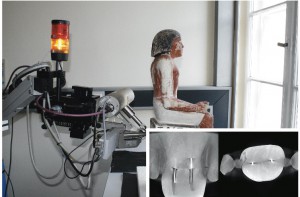 12th April, 2016
12th April, 2016
Location: Gobelin-Saal, Bode-Museum, Berlin.
This workshop brings together an outstanding panel of experts in Cultural Heritage Science. They will be sharing their knowledge and recent findings on the making and historical significance of artifacts, on efficient and sustainable conservation and restoration strategies; art-technological studies; 2D and 3D analytical imaging techniques; digitization; archaeometric and bioarchaeological studies. For these study, integrated analytical strategies are required, combining different non- or minimal-invasive analytical techniques and examinations, to allow insights into materials from micro- and nanoscales.
The institutions working in the field of cultural heritage sciences face the challenge of studying very diverse art and archaeological objects from different perspectives.
This is the first Italian-German workshop on cutting-edge technological developments and new infrastructure initiatives in the field of Cultural Heritage Science. It offers a detailed view on renowned Italian and German institutions and their current research activities as well as recently created infrastructures such as the European infrastructure IPERION-CH. It will be a stimulating platform of intense exchange of stakeholders, users and researchers creating new synergies for the development.
Workshop: CECAM Flagship – Chemical Energy at the Nanoscale
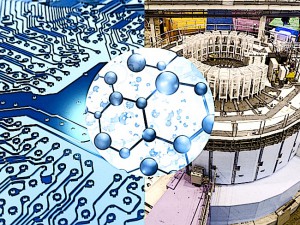 5th April – 7th April 2016, Zaragoza (Spain)
5th April – 7th April 2016, Zaragoza (Spain)
CECAM-ES. A recent CECAM Flagship Workshop held in Zaragoza (Spain) brought together current computational and experimental efforts aimed at exploring the transport, conversion, and storage of chemical energy at the nanoscale. This workshop was organized by Felix Fernandez-Alonso (Rutherford Appleton Laboratory, UK) and Fernando Bresme (Imperial College, UK). Roberto Senesi from the NAST Center (Italy) gave an invited talk on how epithermal neutrons can be used to benchmark state-of-the-art computational methods in the context of energy materials.
(Credit: Jeff Arnstroy, FSFS)
School: XIV School of Neutron Scattering (SONS) “Designing and buildind a Neutron Instrument”

ETTORE MAJORANA FOUNDATION AND CENTRE FOR SCIENTIFIC CULTURE
1st April – 9th April 2016, Erice (Italy)
Application deadline: 1st March 2016
Related Information:
Web site
Project: IPERION CH.it – New opportunities for researchers in cultural heritage
New opportunities for research in Cultural Heritage.
The Italian network within E-RIHS, the European Infrastructure for Heritage Science, selected by European Strategy Forum on Research Infrastructures (ESFRI) in the Roadmap 2016.
Workshop: Research @ NAST Centre – 29th February
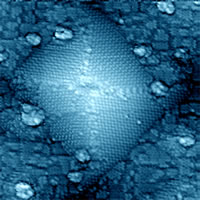 29th February 2016, Rome
29th February 2016, Rome
Location: Seminar Room, Department of Chemical Science and Technologies
Università degli Studi Di Roma Tor Vergata
Related Information: Agenda
Seminar: “Intercalation Phenomena in Carbon-based Nanostructures: from Molecules to Macromolecules”
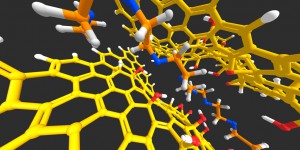 Prof. Felix Fernandez Alonso, ISIS (Pulsed Neutron & Muon Source, Rutherford Appleton Laboratory, Chilton, Didcot, Oxfordshire OX11 0QX) and University College London (UK)
Prof. Felix Fernandez Alonso, ISIS (Pulsed Neutron & Muon Source, Rutherford Appleton Laboratory, Chilton, Didcot, Oxfordshire OX11 0QX) and University College London (UK)
“Intercalation Phenomena in Carbon-based Nanostructures: from Molecules to Macromolecules”
18th February at 14:00
Location: Seminar Room, Department of Chemistry, Via Ricerca Scientifica 1, 00133



